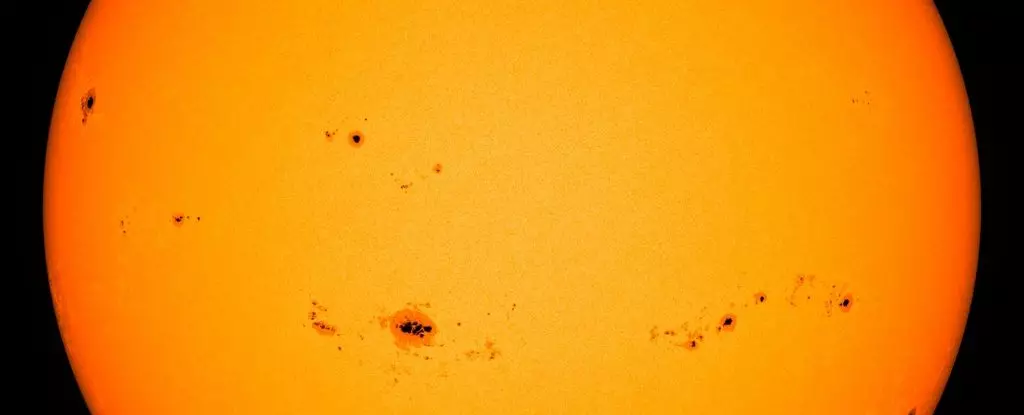Recent declarations from NASA, the National Oceanic and Atmospheric Administration (NOAA), and the Solar Cycle Prediction Panel have confirmed that our Sun has entered the phase known as solar maximum. This period marks the peak of the Sun’s roughly 11-year activity cycle, leading to an increase in solar phenomena including sunspots, solar flares, and coronal mass ejections. As we delve into this intricate cosmic dance, it is essential to understand what these terms mean, their implications for space weather, and how they affect life on Earth.
Every eleven years, the Sun experiences fluctuations in its activity, characterized by varying numbers of sunspots—regions where the Sun’s magnetic field is particularly strong. During solar minimum, these sunspots are at their lowest, while solar maximum is marked by their abundance, resembling freckles over the Sun’s surface. With this increase in sunspots comes heightened solar activity, leading to solar flares—explosions that release energy and radiation—and coronal mass ejections, which can shoot billions of tons of solar material into space.
Despite the predictability of this cycle, precise forecasting remains elusive. Scientists are still grappling with questions surrounding the underlying mechanisms that drive these solar cycles. According to solar astrophysicist Michael Wheatland, the complexities of the solar dynamo—responsible for generating the Sun’s magnetic fields—pose challenges that continue to puzzle the scientific community.
Sunspots serve as a vital indicator for solar activity. Observing their patterns allows scientists to track the solar cycle. This measurement relies on the relationship between the number of sunspots and the frequency of solar flares and coronal mass ejections. While solar maximum generally signifies turbulent activity, there are variations in intensity and duration. As meteorologist Elsayed Talaat points out, while the current phase suggests heightened solar activity, the peak of this cycle may still remain undetermined for months or even years.
The Sun’s fluctuations can have significant consequences for Earth. Solar flares can interrupt radio communications, while coronal mass ejections can disrupt satellites and electrical grids. When charged particles from solar winds interact with Earth’s magnetic field, geomagnetic storms can ensue, producing beautiful auroras but also posing risks to technology infrastructure.
Solar activity is not merely a topic of academic interest; it has tangible consequences for our daily lives, particularly concerning technology that relies on electromagnetic systems. From GPS devices to power grids, disruptions caused by solar flares and coronal mass ejections can lead to outages and malfunctions. Moreover, as this solar cycle progresses, scientists are closely monitoring its strength. Current predictions suggest that we are witnessing a stronger cycle than initially estimated, yet not unprecedented in the observed history of solar activity.
The most powerful solar flare recorded in this cycle—a notable X9.0 flare—occurred on October 4. While significant, particularly concerning the potential for interference with earthly technologies, it doesn’t hold the top spot among the most severe solar events on record. In fact, historical solar flares have produced much more substantial effects than what we currently experience.
The current cycle has unveiled intriguing possibilities regarding predictive models for solar activity. While some scientists underestimated the intensity of this cycle, others anticipated stronger solar phenomena with greater accuracy. Learning from these discrepancies may offer crucial insights into the mechanics of the Sun, ultimately improving our ability to forecast future cycles more reliably.
As we journey further into this solar maximum, scientists are almost certain of experiencing heightened space weather phenomena. Yet whilst concerns may loom regarding potential consequences for technology and infrastructure, there is also an opportunity for enhanced understanding of our nearest star. This ongoing research can illuminate the complexities of solar behavior, fostering a better comprehension of our cosmic environment.
As we face this solar maximum, the implications of the Sun’s increased activity prompt a blend of caution and curiosity. The cycle leads not only to technological challenges but also to awe-inspiring natural displays like auroras. As we embrace the next phase of solar activity, let us remain vigilant in our technological preparedness while also marveling at the unpredictable beauty of our Sun. The journey through yet another solar cycle beckons us to explore, understand, and appreciate the magnificent forces at play in the cosmos.


Leave a Reply